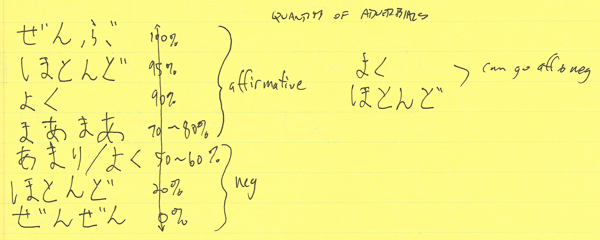With the goal of stirring up even more interest in Murakami between now and mid-October, when the Nobel Prizes are announced, I will post a small piece of Murakami translation once a week from now until the announcement. You can see the other entries in this series here: 1.

The boku narrator finishes reminiscing about his summer day spent with kimi’s shadow and invites the reader to go back to the Town (街に戻ろう) and experience it along with him. I translated these sections in present tense, partially as a nod to Alfred Birnbaum. Once you read it that way, it almost feels wrong to try and render it in past tense. Also, it does neatly solve the narrative problem – the story’s framing devices are translated in past tense (other than the invitation above), as they clearly look back on boku’s time spent in the Town, but the point of narration for the meat of the story (the parts in the Town) is much closer to the action, and it’s fun to feel the Town so immediately surrounding you as you read.
As with Hard-boiled Wonderland, the first thing described upon arrival are the beasts and their daily ritual as they walk through the Town and out of the Gate. After a few days boku finally visits the Library:
On the third day after my arrival in the Town, I push open the door of the Library. The door opens with a creak, and a hallway runs far into the depths within. The air is stale and dusty, and a few yellow light bulbs hang from the high ceiling. It smells like dried sweat. The light barely illuminates the hallway and is so dim that even my body is fuzzy, as though it will be sucked into some other place. Worn down cedar floorboards, plaster walls that seemed to have discolored to match the light of the light bulbs; the hallway continues forever, turning several times as it goes. The building must be deeper than it is wide. I feel like I’m descending into the earth.
I continue walking, and just when I start to feel like I won’t ever get anywhere but can’t go back, an entrance suddenly appears. A delicate door inlaid with polished glass. I turn the aged brass knob and open the door. Inside is a perfectly square room about five meters on all sides. There are no windows and no decorations. There is a modest wooden bench, and a rusted heater is set in the middle of the room with a kettle on top giving off white steam. Straight ahead is a circulation counter, and beyond that there is a door that appears to lead to the archives. Which means this must be the Library. I sit on the wooden bench and warm my hands while I wait for someone to come.
**
You come through the door in the back thirty minutes later.
“I’m sorry,” you say. “I didn’t know that anyone was going to be coming.”
I smile but don’t know exactly why.
“As I’m sure you know, hardly anyone comes here ever since all the books went away.”
The kettle gives a rattle and purrs like a cat.
“Now, what were you here for?” you ask.
I’m looking for old dreams.
“Old dreams.” You look at me with an anxious smile on your face. Of course you don’t remember me. Because the things that connect us are nothing more than a few uncertain events that happened long, long ago in a shadow country.
“Yes, old dreams” is all I reply.
“I’m terribly sorry,” you say still smiling that smile. “But only the Prophet is allowed to touch the old dreams.”
Silently I remove my black glasses and show you my eyes. They are unmistakably the weak eyes of the Prophet. I was given them when I entered the Town.
“I see,” you say and glance downward. “Where shall we begin?”
“For now, I’d like to see a few.”
Nothing makes a sound in the circulation room, and the dust-like air has settled over the room. While you prepare the old dreams, I sit on the bench and casually watch you as I drink the kettle’s hot coffee from an enamel cup. You haven’t changed at all. You are just as you were that summer evening.
“Haven’t I met you somewhere?” I ask, trying to insinuate an answer.
You lift your head from an old notebook on the counter, stare at my face for a moment, and then shake your head.
“No, unfortunately not.” Your smile refuses to disappear. “But I’ve lived in the Town forever, so maybe we have met somewhere. It’s a very small Town after all.”
“But I just came to the Town three days ago.”
“Three days?” You shake your head in disbelief. “Well, you must be mistaken then. Because I’ve been in the Town since I was born.”
“My apologies,” I say, backing down. “Do you have a younger sister or a cousin that looks a lot like you?”
“No, I don’t,” you say blushing slightly and giving a shake of your head.
I drink my coffee silently.
The Library’s ceiling is high. And quiet as the bottom of the sea.
Parts of the description of the Library are similar, but much of it has been reworked. The biggest difference, of course, is that the reader knows who the Librarian is. Part of the greatness of Hard-boiled Wonderland is slowly getting to know the Librarian and realizing her connection with the other half of the novel. Here we know there is a connection between boku and kimi, but we’re still unsure of how it will play out in the Town.





